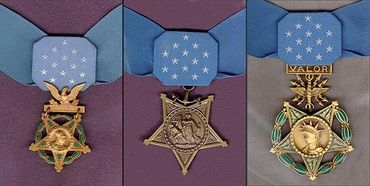List of Medal of Honor recipients
|
||||||||||||

A Medal of Honor on display
|
||||||||||||
The Medal of Honor was created during the American Civil War and is the highest military decoration presented by the United States government to a member of its armed forces. The recipient must have distinguished themselves at the risk of their own life above and beyond the call of duty in action against an enemy of the United States. Due to the nature of this medal, it is commonly presented posthumously.[1]
The President of the United States, in the name of the United States Congress, has awarded 3,468 Medals of Honor to the nation's soldiers, sailors, airmen, marines, and coast guardsmen since the decoration's creation in 1861.[2] The citations highlighting these acts resided in archives, some for more than 100 years and were only sporadically printed. In 1973, the U.S. Senate ordered the citations compiled and printed as Committee on Veterans' Affairs, U.S. Senate, Medal of Honor recipients: 1863–1973 (Washington, D.C.: Government Printing Office, 1973). This book was later updated and reprinted in 1979.[3]
The first Army Medal of Honor was awarded to Private Jacob Parrott during the American Civil War for his role in the Great Locomotive Chase. The only female Medal of Honor recipient is Mary Edwards Walker, a Civil War surgeon. Her medal was rescinded in 1917 along with many other non-combat awards, but it was restored by President Jimmy Carter in 1977.[4]
While current regulations, (10 U.S.C. § 6241), beginning in 1918, explicitly state that recipients must be serving in the U.S. Armed Forces at the time of performing a valorous act that warrants the award, exceptions have been made. For example, Charles Lindbergh, while a reserve member of the U.S. Army Air Corps, received his Medal of Honor as a civilian pilot. In addition, the Medal of Honor was presented to the British Unknown Warrior by General Pershing on October 17, 1921; later the U.S. Unknown Soldier was reciprocally awarded the Victoria Cross, Britain's highest award for gallantry, on November 11, 1921. Although being a U.S. citizen is not a prerequisite for eligibility to receive the medal, apart from a few exceptions, Medals of Honor can be awarded to only members of the U.S. armed forces. Sixty-one Canadians who were serving in the United States armed forces have received the Medal of Honor; most received it for actions in the American Civil War. Since 1900, only four have been awarded to Canadians.[5] In the Vietnam War, Peter C. Lemon was the only Canadian recipient of the Medal of Honor.[6]
American Civil War
- Main articles: List of American Civil War Medal of Honor recipients: A–F, List of American Civil War Medal of Honor recipients: G–L, List of American Civil War Medal of Honor recipients: M–P, List of American Civil War Medal of Honor recipients: Q–S and List of American Civil War Medal of Honor recipients: T–Z
The American Civil War (1861–1865) was an undeclared war between the United States (the Union) and the Southern states of the newly formed Confederate States of America under Jefferson Davis. The Medal of Honor was established during this conflict; 1522 were awarded (32 posthumously) for acts of bravery and gallantry in combat.[2] Almost half of all of the Medals of Honor that have been awarded were presented for actions in the Civil War.[2]
Indian Wars
The term Indian Wars is the name generally used in the United States to describe a series of conflicts between the colonial or federal government and the American Indian population that resided in North America before the arrival of white settlers.[7] During this conflict the Medal of Honor was presented to 426 soldiers, 13 posthumously for acts of bravery and gallantry in combat.[2]
Korean Expedition
The United States expedition to Korea in 1871, also known as Sinmiyangyo (Western Disturbance of the Year Sinmi year), was the first American military action in Korea. It took place predominantly on and around the Korean island of Ganghwa. The reason for the presence of the American military expeditionary force in Korea was to support an American diplomatic delegation sent to establish trade and diplomatic relations with Korea and to ascertain the fate of the General Sherman merchant ship. The isolationist nature of the Joseon Dynasty government and the assertiveness of the Americans led to an armed conflict between the two parties. Eventually, the United States failed to secure its objectives.[8]
| Image | Name | Service | Rank | Place of action | Date of action | Unit | Notes[9] |
|---|---|---|---|---|---|---|---|
|
—
|
John Andrews | Navy | Ordinary Seaman | aboard the USS Benicia | June 9, 1871 – June 10, 1871 | USS Benicia | Stood on the gunwale on the Benicia's launch, lashed to the ridgerope and remained unflinchingly in this dangerous position and gave his soundings with coolness and accuracy under a heavy fire. |
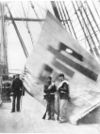 (Brown at right) (Brown at right) |
Charles Brown | Marine Corps | Corporal | aboard the USS Colorado | June 11, 1871 | USS Colorado | Assisted in capturing the Korean flag from the citadel of the fort |
|
—
|
John Coleman | Marine Corps | Private | aboard the USS Colorado | June 11, 1871 | USS Colorado | For hand-to-hand combat and saving the life of Alexander McKenzie |
|
—
|
James Dougherty | Marine Corps | Private | aboard the USS Carondelet | June 11, 1871 | USS Carondelet | Returned to duty after being wounded several times |
|
—
|
Frederick Franklin | Navy | Quartermaster | aboard the USS Colorado | June 11, 1871 | USS Colorado | For assuming command of Company D, after Lt. McKee was wounded, and handling the company until relieved |
|
—
|
Patrick H. Grace | Navy | Chief Quartermaster | aboard the USS Benicia | June 10, 1871 – June 11, 1871 | USS Benicia | Carrying out his duties with coolness, Grace set forth gallant and meritorious conduct throughout this action |
 (Hayden at left) (Hayden at left) |
Cyrus Hayden | Navy | Carpenter | aboard the USS Colorado | June 11, 1871 | USS Colorado | Serving as color bearer of the battalion, Hayden planted his flag and protected it under heavy fire |
.jpg) |
William F. Lukes | Navy | Landsman | Ganghwa Island | June 9, 1871 – June 10, 1871 | USS Colorado | Fighting the enemy inside the fort, Lukes received a severe cut over the head |
|
—
|
Alexander McKenzie | Navy | Boatswain's Mate | aboard the USS Colorado | June 11, 1871 | USS Colorado | Fighting at the side of Lt. McKee during this action, McKenzie was struck by a sword and received a severe cut in the head from the blow. |
|
—
|
Michael McNamara | Marine Corps | Private | aboard the USS Benicia | June 11, 1871 | USS Benicia | For taking a match-lock from the hands of the enemy while advancing to the parapet |
|
—
|
James F. Merton | Navy | Landsman | Ganghwa Island | June 9, 1871 – June 10, 1871 | USS Colorado | Merton was severely wounded in the arm while trying to force his way into the fort |
|
—
|
Michael Owens | Marine Corps | Private | aboard the USS Colorado | June 11, 1871 | USS Colorado | Fighting courageously in hand-to-hand combat, Owens was badly wounded by the enemy during this action |
 (Purvis in center) (Purvis in center) |
Hugh Purvis | Marine Corps | Private | aboard the USS Alaska | June 11, 1871 | USS Alaska | Braving the enemy fire, Purvis was the first to scale the walls of the fort and capture their flag |
|
—
|
Samuel F. Rogers | Navy | Quartermaster | aboard the USS Colorado | June 11, 1871 | USS Colorado | Fighting courageously at the side of Lt. McKee during this action, Rogers was wounded by the enemy |
|
—
|
William Troy | Navy | Ordinary Seaman | aboard the USS Colorado | June 11, 1871 | USS Colorado | Fighting at the side of Lt. McKee, by whom he was especially commended, Troy was badly wounded by the enemy |
Spanish-American War
The Spanish-American War (Spanish: Guerra Hispano-Estadounidense, desastre del 98, Guerra Hispano-Cubana-Norteamericana or Guerra de Cuba ) was a military conflict between Spain and the United States that began in April 1898. Hostilities halted in August of that year, and the Treaty of Paris was signed in December. The war began after the American demand for Spain's peacefully resolving the Cuban fight for independence was rejected, though strong expansionist sentiment in the United States may have motivated the government to target Spain's remaining overseas territories: Cuba, Puerto Rico, the Philippines, Guam and the Caroline Islands.[10]
Riots in Havana by pro-Spanish "Voluntarios" gave the United States a reason to send in the warship USS Maine to indicate high national interest. Tension among the American people was raised because of the explosion of the USS Maine, and "yellow journalism" that accused Spain of extensive atrocities, agitating American public opinion. The war ended after decisive naval victories for the United States in the Philippines and Cuba. The Treaty of Paris ended the conflict 109 days after the outbreak of war giving the United States ownership of the former Spanish colonies of Puerto Rico, the Philippines and Guam.[11]
Samoan Civil War
The Samoan Civil War is a Western definition of political activity in the Samoa Islands of the South Pacific in the late 19th century. By this non-Samoan definition, the Samoan Civil Wars were a series of wars between Germany, the United Kingdom, and the United States, ending in the partitioning of the island chain in 1899. The concluding event was the Second Samoan Civil War. The first Samoan Civil War lasted for eight years. The warring Samoan parties were supplied arms, training and sometimes even combat troops by Germany, Britain and the United States. The three powers were playing them off against each other as each country wanted Samoa as a refueling station for coal fired shipping. They also wanted Samoa due to the scarcity of unclaimed territory from 1870 onwards to gain more power in Europe.[12]
| Image | Name | Service | Rank | Place of action | Date of action | Unit | Notes[13] |
|---|---|---|---|---|---|---|---|
|
—
|
Frederick T. Fisher | Navy | Gunner's Mate First Class | aboard the USS Philadelphia, Samoa | April 1, 1899 | USS Philadelphia | For distinguishing himself by his conduct in the presence of the enemy |
|
—
|
Bruno A. Forsterer | Marine Corps | Sergeant | Samoa | April 1, 1899 | Unknown | For distinguished conduct in the presence of the enemy. |
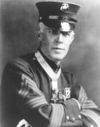 |
Henry L. Hulbert | Marine Corps | Private | Samoa | April 1, 1899 | Unknown | For distinguished conduct in the presence of the enemy. Subsequently awarded the Navy Cross and the Distinguished Service Medal for actions during World War I. |
|
—
|
Michael J. McNally | Marine Corps | Sergeant | Samoa | April 1, 1899 | Unknown | For distinguished conduct in the presence of the enemy |
Philippine-American War
The Philippine-American War[n 1] was an armed military conflict between the United States and the First Philippine Republic, fought between 1899 to at least 1902, which arose from a Filipino political struggle against U.S. occupation of the Philippines. While the conflict was officially declared over on July 4, 1902,[14][15][16] American troops continued hostilities against remnants of the Philippine Army and other resistance groups until 1913, and some historians consider these unofficial extensions part of the war.[16]
Eighty-six men were awarded the Medal of Honor for their actions in the Philippine–American War: 70 from the Army, 10 from the Navy, and 6 from the Marine Corps. Four of the awards were posthumous. Among the recipients were Webb Hayes, the son of former U.S. President Rutherford B. Hayes, and two prominent Marine Corps officers, Hiram I. Bearss and David Dixon Porter. Bearss became known for leading long-range reconnaissance patrols behind enemy lines and was later wounded as a colonel in World War I. Porter was from a distinguished military family and rose to become a major general. José B. Nísperos, a member of the Philippine Scouts who was honored for continuing to fight after being wounded, was the first Asian recipient of the Medal of Honor.[17]
Boxer Rebellion
The Boxer Movement or Boxer Rebellion, which occurred in China from November 1899 to September 7, 1901, was an uprising by members of the Chinese Society of Right and Harmonious Fists against foreign influence in areas such as trade, politics, religion and technology that occurred in China during the final years of the Manchu rule (Qing Dynasty). The members of the Society of Right and Harmonious Fists were simply called boxers by the Westerners due to the martial arts and calisthenics they practiced. The uprising began as an anti-foreign, anti-imperialist peasant-based movement in northern China. They attacked foreigners who were building railroads and violating Feng shui, as well as Christians, who were held responsible for the foreign domination of China. In June 1900, the Boxers invaded Beijing and killed 230 non-Chinese. Tens of thousands of Chinese Christians, Catholic and Protestant alike, were killed mostly in Shandong and Shanxi Provinces as part of the uprising. The government of Empress Dowager Cixi was not helpful, and diplomats, foreign civilians, soldiers and some Chinese Christians retreated to the legation quarter where they held out for fifty-five days until a multinational coalition rushed 20,000 troops to their rescue. The Chinese government was forced to indemnify the victims and make many additional concessions. Subsequent reforms implemented after the crisis of 1900 laid the foundation for the end of the Qing Dynasty and the establishment of the modern Chinese Republic.[18]
During the Boxer rebellion, 59 American servicemen received the Medal of Honor for their actions. Four of these were for Army personnel, twenty-two went to navy sailors and the remaining thirty-three went to marines. Harry Fisher was the first Marine to receive the medal posthumously and the only posthumous recipient for this conflict.[2]
United States occupation of Veracruz, 1914
The United States occupation of the Mexican port of Veracruz lasted for six months in response to the Tampico Affair of April 9, 1914. The incident came in the midst of poor diplomatic relations between Mexico and the United States, related to the ongoing Mexican Revolution.[19]
Secretary of the Navy Josephus Daniels ordered that 56 Medals of Honor be awarded to participants in the occupation of Veracruz, the most for any single action before or since. In total 63 Medals of Honor were received for actions during the occupation; 1 Army, 9 to members of the United States Marine Corps and 53 to Navy personnel.[2]
Invasion and occupation of Haiti
The first United States occupation of Haiti began on July 28, 1915 and ended in mid-August 1934. Later occupations of Haiti include those which began 1994 and 2004 (though under the UN banner, the U.S. was the prime mover of the actions).[20]
| Image | Name | Service | Rank | Place of action | Date of action | Unit | Notes[21][22] |
|---|---|---|---|---|---|---|---|
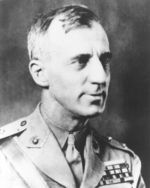 |
Smedley Butler | Marine Corps | Major | Fort Riviere, Haiti | November 17, 1915 | in a company composed of the fifth, thirteenth and twenty-third companies and the Marine and sailor detachment from the USS. CONNECTICUT | Second award - previously awarded a Medal of Honor for action in the Mexican Campaign. |
 |
William R. Button | Marine Corps | Corporal | near Grande Riviere, Haiti | October 31, 1919 – November 1, 1919 | USS Antares (AG-10) 7th Marines | For the assassination of rebel leader Charlemagne Péralte and the routing of his followers |
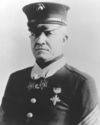 |
Daniel Daly | Marine Corps | Gunnery Sergeant | near Fort Liberte, Haiti | October 24, 1915 | 15th Company | Second award - previously awarded a Medal of Honor for action in the Boxer Rebellion |
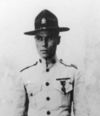 |
Herman H. Hanneken | Marine Corps | Second Lieutenant | near Grande Riviere, Haiti | October 31, 1919 – November 1, 1919 | USS Antares (AG-10) 7th Marines | For the assassination of rebel leader Charlemagne Péralte and the routing of his followers |
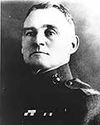 |
Ross L. Iams | Marine Corps | Sergeant | Fort Riviere, Haiti | November 17, 1915 | in a company composed of the fifth, thirteenth and twenty-third companies and the Marine and sailor detachment from the USS CONNECTICUT | Approaching a breach in the wall which was the only entrance to the fort, Sergeant Iams unhesitatingly jumped through the breach despite constant fire from the Cacos and engaged the enemy in a desperate hand-to-hand combat until the bastion was captured and Caco resistance neutralized. |
|
—
|
Samuel Marguiles | Marine Corps | Private | Fort Riviere, Haiti | November 17, 1915 | in a company composed of the fifth, thirteenth and twenty-third companies and the Marine and sailor detachment from the USS CONNECTICUT | Served under the name Samuel Gross. |
 |
Edward A. Ostermann | Marine Corps | First Lieutenant | near Fort Liberte, Haiti | October 24, 1915 | Fifteenth Company | In command of one of the three squads which advanced in three different directions, led his men forward, surprising and scattering the Cacos, and aiding in the capture of Fort Dipitie. |
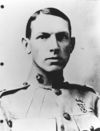 |
William P. Upshur | Marine Corps | Captain | near Fort Liberte, Haiti | October 24, 1915 | Fifteenth Company | In command of the three squads which advanced in three different directions, led his men forward, surprising and scattering the Cacos, and aiding the capture of Fort Dipitie. |
Occupation of the Dominican Republic
The United States occupied the Dominican Republic from 1916 to 1924. In May 1917, Rear Admiral William Caperton forced Arias to leave Santo Domingo by threatening the city with naval bombardment. U.S. Marines invaded and landed took control of the country within two months, and in November the U.S. imposed a military government. The Marines restored order throughout most of the republic (with the exception of the eastern region); the country's budget was balanced, its debt was diminished, and economic growth resumed; infrastructure projects produced new roads that linked all the country's regions for the first time in its history; a professional military organization, the Dominican Constabulary Guard, replaced the partisan forces that had waged a seemingly endless struggle for power.[23]
| Image | Name | Service | Rank | Place of action | Date of action | Unit | Notes[24] |
|---|---|---|---|---|---|---|---|
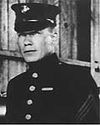 |
Joseph A. Glowin | Marine Corps | Corporal | Guayacanes, Dominican Republic | July 3, 1916 | 13th Company, Artillery Battalion, 1st Brigade | For action against a considerable force of rebels |
|
—
|
Ernest C. Williams | Marine Corps | First Lieutenant | San Francisco de Macorís, Dominican Republic | November 29, 1916 | 1st Brigade | For leading the capture of a fort |
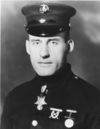 |
Roswell Winans | Marine Corps | First Sergeant | Guayacanes, Dominican Republic | July 3, 1916 | 1st Brigade | For action against a considerable force of rebels |
World War I
World War I, also known as the First World War and the Great War, was a global military conflict which took place primarily in Europe from 1914–1918. Over 40 million casualties resulted, including approximately 20 million military and civilian deaths.[25] Over 60 million European soldiers were mobilized from 1914–1918.[26] The immediate cause of the war was the June 28, 1914 assassination of Archduke Franz Ferdinand, heir to the Austro-Hungarian throne, by Gavrilo Princip, a Bosnian Serb citizen of Austria-Hungary and member of the Black Hand. The retaliation by Austria-Hungary against Serbia activated a series of alliances that set off a chain reaction of war declarations. Within a month, much of Europe was in a state of open warfare.[27]
During this War, 119 men received the Medal for their actions, 33 of them posthumously.[2]
Occupation of Nicaragua
The United States occupied Nicaragua from 1909 to 1933 and intervened in the country several times before that. The American interventions in Nicaragua were designed to prevent the construction of a trans-isthmian canal by any nation but the USA. Nicaragua assumed a quasi-protectorate status under the 1916 Chamorro-Bryan Treaty. The occupation ended as Augusto César Sandino, a Nicaraguan revolutionary, led guerrilla armies against US troops. Furthermore, the onset of the Great Depression made it costly for the USA to maintain occupation.[28]
| Image | Name | Service | Rank | Place of action | Date of action | Unit | Notes[29] |
|---|---|---|---|---|---|---|---|
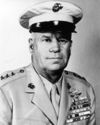 |
Christian F. Schilt | Marine Corps | First Lieutenant | Quilali, Nicaragua | January 6, 1928 – January 8, 1928 | Observation Squadron 7-M | For evacuating wounded Marines by plane while under fire |
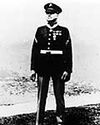 |
Donald L. Truesdale | Marine Corps | Corporal | near Constancia, near Coco River, northern Nicaragua | April 24, 1932 | a Guardia Nacional Patrol | Served under the name "Truesdell" before officially changing name to "Truesdale". Lost his hand while attempting to save his patrol from an accidentally activated grenade. |
World War II
World War II, or the Second World War, was a global military conflict, the joining of what had initially been two separate conflicts. The first began in Asia in 1937 as the Second Sino-Japanese War; the other began in Europe in 1939 with the German and Russian invasion of Poland.[n 2] This global conflict split the majority of the world's nations into two opposing military alliances: the Allies and the Axis powers. It involved the mobilization of over 100 million military personnel, making it the most widespread war in history, and placed the participants in a state of "total war", erasing the distinction between civil and military resources. This resulted in the complete activation of a nation's economic, industrial, and scientific capabilities for the purposes of the war effort. Over 60 million people, the majority of them civilians, were killed, making it the deadliest conflict in human history.[30] The financial cost of the war is estimated at about a trillion 1944 U.S. dollars worldwide,[31][32] making it the most costly war in capital as well as lives.
During this conflict 464 United States military personnel received the Medal of Honor, 266 of them posthumously. Additionally, the only Medal of Honor recipient in history for the United States Coast Guard received the Medal for his actions during this war.[2]
Korean War
The Korean War was ignited by the 1950 invasion of South Korea by the North Korean Communist state. The attack was motivated by the desire of the North Korean government to unite the peninsula, but in subsidiary was an attempt backed up by Soviet Russia to spread Communism in Asia. In a very narrow sense, some may refer to it as a civil war, though the ideological factor, namely the expansionist policies of Stalinist regimes of Asia, was the main causal factor.[33] After failing to strengthen their cause in the free elections held in South Korea during May 1950[34] and the refusal of South Korea to hold new elections per North Korean demands, the communist North Korean Army moved south on June 25, 1950 to attempt to reunite the Korean peninsula, which had been formally divided since 1948. The conflict was then expanded by the United States and the Soviet Union's involvement as part of the larger Cold War. The main hostilities were during the period from June 25, 1950 until the armistice (ceasefire agreement) was signed on July 27, 1953.[34]
In South Korea, the war is often called "6•25", or the 6•25 War (Korean: 6•25 전쟁), from the date of the start of the conflict or, more formally, Hanguk Jeonjaeng literally “Korean War”. In North Korea, while commonly known as the Korean War, it is formally called the Fatherland Liberation War. In the United States, the conflict was officially termed a police action—the Korean Conflict—rather than a war, largely in order to avoid the necessity of a declaration of war by the U.S. Congress. The war is sometimes called "The Forgotten War" because it is a major conflict of the 20th century that gets far less attention than World War II, which preceded it, and the controversial Vietnam War, which succeeded it.[35] In China, the conflict was known as the War to Resist America and Aid Korea, but is today commonly called the "Korean War".[36]
During this war, 133 Medals of Honor were presented for bravery in action, 95 of them posthumously.[2]
Vietnam War
The Vietnam War, also known as the Second Indochina War, and in Vietnam as the American War, occurred from 1959 to April 30, 1975. The term "Vietnam Conflict" is often used to refer to events which took place between 1959 and April 30, 1975. The war was fought between the Communist-supported Democratic Republic of Vietnam (North Vietnam) and the United States supported Republic of Vietnam (South Vietnam).
Over 1.4 million military personnel were killed in the war (only 4% were members of the United States armed forces), while estimates of civilian fatalities range from 2 to 5.1 million. On April 30, 1975, the capital of South Vietnam, Saigon fell to the communist forces of North Vietnam, effectively ending the Vietnam War.
During the Vietnam War, 246 Medals of Honor were received, 154 of them posthumously. Soldiers of the Army received the most with 160, followed by 57 to the Marines, 16 to the Navy and the remaining 13 to the Air Force.[2] The first medal of the war was presented to Roger Donlon for rescuing and administering first aid to several wounded soldiers and leading a group against an enemy force.[37] The first African American recipient of the war was Milton L. Olive, III who sacrificed himself to save others by smothering a grenade with his body.[38] Riley L. Pitts was killed after attacking an enemy force with rifle fire and grenades and was the first African American commissioned officer of the war to receive the medal.[39] Thomas Bennett was a conscientious objector who received the medal for his actions as a medic;[40] three chaplains received the medal, including Vincent R. Capodanno, who served with the Marine Corps and was known as the Grunt padre.[41]
USS Liberty incident
The USS Liberty incident was an attack on a neutral United States Navy technical research ship, USS Liberty, by Israeli jet fighter planes and motor torpedo boats on June 8, 1967, during the Six-Day War. The combined air and sea attack killed 34 and wounded more than 170 crew members, and damaged the ship severely.[42]
| Image | Name | Service | Rank | Place of action | Date of action | Unit | Notes[43] |
|---|---|---|---|---|---|---|---|
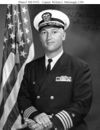 |
William L. McGonagle | Navy | Commander | eastern Mediterranean Sea | June 8, 1967 – June 9, 1967 | USS Liberty (AGTR-5) | Continued to lead his ship despite being severely wounded |
Battle of Mogadishu (1993)
The Battle of Mogadishu (also referred to as the "Battle of the Black Sea") or for Somalis Ma-alinti Rangers (“The Day of the Rangers”) was a battle that was part of Operation Gothic Serpent that was fought on October 3 and 4, 1993, in Mogadishu, Somalia, by forces of the United States supported by UNOSOM II against Somali militia fighters loyal to warlord Mohamed Farrah Aidid. The battle is also referred to as the First Battle of Mogadishu to distinguish it from the later Second Battle of Mogadishu.[44]
This with the * indicates that the Medal of Honor was awarded posthumously
| Image | Name | Service | Rank | Place of action | Date of action | Unit | Notes[45] |
|---|---|---|---|---|---|---|---|
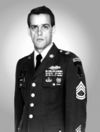 |
Gary Gordon* | Army | Master Sergeant | Mogadishu, Somalia | October 3, 1993 | Delta Force | For volunteering to secure a helicopter crash site while under heavy enemy fire until relief could arrive |
 |
Randy Shughart* | Army | Sergeant First Class | Mogadishu, Somalia | October 3, 1993 | Delta Force | For volunteering to secure a helicopter crash site while under heavy enemy fire until relief could arrive |
War in Afghanistan
The War in Afghanistan (2001–present), which began on October 7, 2001, was launched by the United States, the United Kingdom, and NATO allies in response to the September 11, 2001 attacks. It was the beginning of the Bush administration's War on Terrorism. The stated purpose of the invasion was to capture Osama bin Laden, destroy al-Qaeda, and remove the Taliban regime which had provided support and safe harbor to al-Qaeda.[46] Since 2001 two American service-members have received the Medal of Honor for actions in Afghanistan. Sergeant First Class Jared C. Monti received his medal for being killed after attempting to rescue a wounded soldier who had been wounded by insurgent forces. Lieutenant Michael P. Murphy received his for actions against insurgent forces and for sacrificing his life to call for help when his team had been overwhelmed by a much larger enemy force.[47]
This with the * indicates that the Medal of Honor was awarded posthumously
| Image | Name | Service | Rank | Place of action | Date of action | Unit | Notes[47] |
|---|---|---|---|---|---|---|---|
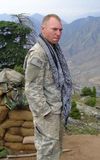 |
Jared C. Monti* | Army | Sergeant First Class | Gowardesh, Afghanistan | June 21, 2006 | 3rd Squadron, 71st Cavalry, 3rd Brigade Combat Team, 10th Mountain Division (Light Infantry) | Killed while trying to rescue a wounded soldier from intense small arms and rocket-propelled grenade fire |
 |
Michael P. Murphy* | Navy | Lieutenant | Kunar Province, Afghanistan | June 28, 2005 | SEALs SDV Team 1 | Led a four-man reconnaissance team in a fight against superior numbers, exposed himself to hostile fire in order to call for help |
Iraq War
The Iraq War, also known as the Second Gulf War,[48] Operation Iraqi Freedom (US),[49] Operation TELIC (UK)[50] or the occupation of Iraq,[51] is an ongoing conflict which began on March 20, 2003 with the United States-led invasion of Iraq by a multinational coalition composed of U.S. and U.K. troops supported by smaller contingents from Australia, Poland, and other nations.[52] Four service members have received the Medal of Honor for actions in Iraq; two from the Army, one from the Marine Corps and one from the Navy. Paul R. Smith was the first to receive it for his actions on April 4, 2003 when he held enemy forces back, allowing other wounded soldiers to be evacuated to safety. The other three, Corporal Jason Dunham of the Marine Corps, Specialist Ross A. McGinnis of the Army and Master-at-Arms Second Class Michael A. Monsoor of the Navy received it after being killed while using their own bodies to smother grenades to protect their comrades.[53] A fifth Medal of Honor was submitted by the Marine Corps for Sergeant Rafael Peralta, who was also killed after smothering a grenade with his body. The request was denied by Secretary of Defense Robert Gates and Peralta received the second highest award for bravery a Marine can receive, the Navy Cross, instead. Members of his family, Congress and the Marine Corps continue to request that Peralta be reconsidered for the Medal of Honor.[54]
This with the * indicates that the Medal of Honor was awarded posthumously
| Image | Name | Service | Rank | Place of action | Date of action | Unit | Notes[53] |
|---|---|---|---|---|---|---|---|
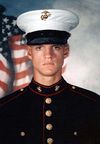 |
Jason Dunham* | Marine Corps | Corporal | Iraq, near Syrian border | April 14, 2004 | 3rd Battalion 7th Marines | Fought hand-to-hand with the enemy and hurled himself on a grenade to protect fellow Marines |
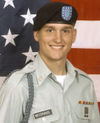 |
Ross A. McGinnis* | Army | Specialist | Adhamiyah, Iraq | December 4, 2006 | C Company, 1-26th Infantry, 1st Infantry Division | Saved the lives of four soldiers by diving on a grenade while inside HMMWV (Humvee) |
 |
Michael A. Monsoor* | Navy | Master-at-Arms Second Class | Ramadi, Iraq | September 29, 2006 | SEAL Team Three, Delta Platoon | Saved the lives of his fellow SEALs at his sniper position by diving on a grenade |
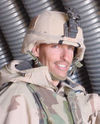 |
Paul R. Smith* | Army | Sergeant First Class | near Baghdad, Iraq | April 4, 2003 | B Company, 11th Engineer Battalion | Held the enemy at bay allowing for the wounded to be carried out |
Peacetime
Before World War II, the Medal of Honor could be received for actions not involving direct combat with the enemy and 193 men earned the medal in this way.[2] Most of these medals were presented to members of the United States Navy for rescuing or attempting to rescue someone from drowning.[2] In addition to the medals that were presented for lifesaving acts, one Medal of Honor was presented to William Halford who sailed in a small boat for 31 days to get help for the other members of the USS Saginaw who had been stranded on an island.[55] Three explorers were also presented with the medal by special acts of Congress. Charles Lindbergh received the medal for flying the first solo non-stop flight across the Atlantic Ocean as well as Floyd Bennett and Richard Evelyn Byrd who received it for their participation in what was thought to be the first successful heavier-than-air flight to the North Pole and back. One recipient, Adolphus W. Greely received his for a lifetime of military service.[56]
Foreign
While current regulations, (e.g., 10 U.S.C. § 6241 (relating to service members in the U.S. Navy and Marine Corps)), beginning in 1918, explicitly state that recipients must be serving in the U.S. Armed Forces at the time of performing a valorous act that warrants the award, exceptions have been made. Apart from these rare exceptions, Medals of Honor can only be awarded to members of the U.S. armed forces - although being a U.S. citizen is not a prerequisite. Sixty-one Canadians who were serving in the United States armed forces have been awarded the Medal of Honor, with a majority awarded for actions in the American Civil War. Since 1900, only four have been awarded to Canadians.[5] In the Vietnam War, Peter C. Lemon was the only Canadian recipient of the Medal of Honor.[57]
The Medal of Honor has also been presented to several unknown soldiers British Unknown Warrior in the United Kingdom by General Pershing on October 17, 1921; later the U.S. Unknown Soldier was reciprocally awarded the Victoria Cross, Britain's highest award for gallantry, on November 11, 1921. The Medal of Honor was also presented to The Romanian Unknown Soldier, The Unknown Soldier of France, entombed under the Arc de Triomphe, The Unknown Soldier of Belgium and The Unknown Soldier of Italy, entombed in the Monument of Vittorio Emanuele II.[58]
Notes
- ↑ This conflict is also known as the Philippine Insurrection. This name was historically the most commonly used in the U.S., but Filipinos and some American historians refer to these hostilities as the Philippine-American War, and, in 1999, the U.S. Library of Congress reclassified its references to use this term.
- ↑ Official military histories in Commonwealth nations refer to the conflict as the Second World War, while the United States' official histories refer to the conflict as World War II. English translations of the official histories of other nations tend to resolve into English as Second World War also, for example zweite weltkrieg in German. See C.P. Stacey Official History of the Canadian Army in the Second World War, for example. "Official" usage of these terms is giving way to popular usage and the two terms are becoming interchangeable even in formal military history.
References
 This article incorporates public domain material from websites or documents of the United States Army Center of Military History.
This article incorporates public domain material from websites or documents of the United States Army Center of Military History.
- ↑ "A Brief History—The Medal of Honor". Frequently Asked Questions (FAQ). Department of Defense. August 8, 2006. http://www.defenselink.mil/faq/pis/med_of_honor.html. Retrieved February 9, 2010.
- ↑ 2.00 2.01 2.02 2.03 2.04 2.05 2.06 2.07 2.08 2.09 2.10 2.11 "Medal of Honor recipients". Statistics of Soldiers, Sailors, Airmen, Marines, and Coast Guardsmen who received the Medal of Honor. United States Army Center of Military History. June 8, 2009. http://www.history.army.mil/html/moh/mohstats.html. Retrieved March 18, 2008.
- ↑ "Medal of Honor recipients". Listing of Soldiers, Sailors, Airmen, Marines, and Coast Guardsmen who received the Medal of Honor during World War II. United States Army Center of Military History. June 8, 2009. http://www.history.army.mil/moh.html. Retrieved March 17, 2008.
- ↑ "Mary Edwards Walker". Women in History. http://www.lkwdpl.org/wihohio/walk-mar.htm. Retrieved July 23, 2006.
- ↑ 5.0 5.1 "Canada honours winners of top U.S. medal". CBC News. July 1, 2005. http://www.cbc.ca/canada/story/2005/07/01/canadians-usmedal050701.html. Retrieved July 20, 2006.
- ↑ "Thousands of Canadians, including a Medal of Honor recipient, served with the U.S. military in Vietnam". Veterans With a Mission. http://www.cbc.ca/canada/story/2005/07/01/canadians-usmedal050701.html. Retrieved July 20, 2006.
- ↑ "Winning the west the Army in the Indian Wars, 1865-1890". United States Army Center of Military History. April 27, 2001. http://www.history.army.mil/books/amh/AMH-14.htm. Retrieved February 15, 2010.
- ↑ Tyson, Carolyn A. (March 5, 2007). "Marine Amphibious Landing in Korea, 1871". Naval Historical Foundation. http://www.history.navy.mil/library/online/marine_amphib_korea.htm. Retrieved February 15, 2010.
- ↑ "Medal of Honor recipients". American Medal of Honor recipients for the 1871 Korean Campaign. United States Army Center of Military History. June 8, 2009. http://www.history.army.mil/html/moh/korean1871.html. Retrieved June 8, 2009.
- ↑ "The Price of Freedom: Americans at War—Spanish American War". National Museum of American History. 2005. http://americanhistory.si.edu/militaryhistory/printable/section.asp?id=7.
- ↑ Dolan, Edward F. (April 27, 2001). The Spanish-American War. The Millbrook Press, Inc.. ISBN 0-7613-1453-9. http://books.google.com/?id=mHA7k2VInvEC&printsec=frontcover&q=. Retrieved February 15, 2010.
- ↑ Stevenson, Robert Louis. A Footnote to History: Eight Years of Trouble in Samoa. http://ebooks.adelaide.edu.au/s/stevenson/robert_louis/s848fh/. Retrieved February 15, 2010.
- ↑ "Medal of Honor recipients". American Medal of Honor recipients for the Philippine Insurrection. United States Army Center of Military History. June 8, 2009. http://www.history.army.mil/html/moh/philippine.html. Retrieved June 8, 2009.
- ↑ Delmendo, Sharon (2004). The Star-Entangled Banner: One Hundred Years of America in the Philippines. Rutgers University Press. p. 47. ISBN 0813534119. http://books.google.com/?id=N6nkB_PDdXcC&pg=PA15&dq=Philippine+People+power+revolution. Retrieved December 3, 2007..
- ↑ Agoncillo, Teodoro (1960 (Eighth edition 1990)). History of the Filipino People. Quezon City: Garcia. ISBN 971-1024-15-2.
- ↑ 16.0 16.1 Constantino, Renato (1975). The Philippines: A Past Revisited. ISBN 971-8958-00-2.
- ↑ Owens, Ron (2004). Medal of Honor: Historical Facts & Figures. Paducah, Kentucky: Turner Publishing Company. pp. 71–73, 80–81. ISBN 9781563119958. http://books.google.com/?id=s65pmBAUmD4C.
- ↑ Esherick, Joseph W. (1987). The Origins of the Boxer Uprising. University of California Press. p. 154. ISBN 0-520-06459-3. http://books.google.com/?id=jVESdBSMasMC&printsec=frontcover&dq=The+Origins+of+the+Boxer+Uprising&cd=1#v=onepage&q=Medal%20of%20Honor. Retrieved February 6, 2010.
- ↑ Yockelson, Mitchell (1997). "The United States Armed Forces and the Mexican Punitive Expedition: Part 1". Prologue Magazine 29. http://www.archives.gov/publications/prologue/1997/fall/mexican-punitive-expedition-1.html.
- ↑ Schmidt, Hans (1995). The United States Occupation of Haiti, 1915-1934. Rutgers University Press. ISBN 0-8135-2203-X. http://books.google.com/?id=5GYOqCPdHtwC&printsec=frontcover&dq=The+United+States+Occupation+of+Haiti,+1915-1934&cd=1#v=onepage&q=. Retrieved February 15, 2010.
- ↑ "Medal of Honor recipients". American Medal of Honor recipients for the 1915 Haiti Campaign. United States Army Center of Military History. June 8, 2009. http://www.history.army.mil/html/moh/haiti1915.html. Retrieved June 8, 2009.
- ↑ "Medal of Honor recipients". American Medal of Honor recipients for the 1919–1920 Haiti Campaign. United States Army Center of Military History. June 8, 2009. http://www.history.army.mil/html/moh/haiti1919-20.html. Retrieved June 8, 2009.
- ↑ Haggerty, Richard A. (1989). "Dominican Republic: A Country Study". http://countrystudies.us/dominican-republic/. Retrieved February 16, 2010.
- ↑ "Medal of Honor recipients". American Medal of Honor recipients for the Dominican Campaign. United States Army Center of Military History. June 8, 2009. http://www.history.army.mil/html/moh/dominic.html. Retrieved June 8, 2009.
- ↑ "Military Casualties of World War One". http://www.firstworldwar.com/features/casualties.htm. Retrieved February 11, 2010.
- ↑ "The Treaty of Versailles and its Consequences". http://www.jimmyatkinson.com/papers/versaillestreaty.html. Retrieved February 12, 2010.
- ↑ Keegan, John (1998). The First World War. Hutchinson. ISBN 0091801788.
- ↑ Merrill, Tim (1993). "Nicaragua: A Country Study". http://countrystudies.us/nicaragua/. Retrieved February 15, 2010.
- ↑ "Medal of Honor recipients". American Medal of Honor recipients for the Second Nicaraguan Campaign. United States Army Center of Military History. June 8, 2009. http://www.history.army.mil/html/moh/nicara.html. Retrieved June 8, 2009.
- ↑ Dunnigan, James; Albert Nofi. Dirty Little Secrets of World War II: Military Information No One Told You About the Greatest, Most Terrible War in History, William Morrow & Company, 1994. ISBN 0-688-12235-3
- ↑ Mayer, E. (2000) "World War II" course lecture notes on Emayzine.com (Victorville, California: Victor Valley College)
- ↑ Coleman, P. (1999) "Cost of the War," World War II Resource Guide (Gardena, California: The American War Library)
- ↑ "The Korean War, 1950–1953, (an extract from American Military History, Volume 2 - revised 2005)". http://www.history.army.mil//books/AMH-V2/AMH%20V2/chapter8.htm. Retrieved August 20, 2007.
- ↑ 34.0 34.1 Hermes, Jr., Walter (1966). Truce Tent and Fighting Front. Center of Military History. pp. 2, 6, 9. http://www.history.army.mil//books/korea/truce/fm.htm.
- ↑ "Remembering the Forgotten War: Korea, 1950–1953". Naval History & Heritage Command. http://www.history.navy.mil/ac/korea/korea1.htm. Retrieved August 16, 2007.
- ↑ "War to Resist US Aggression And Aid Korea Marked in DPRK". (China's) Peoples Daily (English version). http://english.people.com.cn/english/200010/26/eng20001026_53620.html. Retrieved August 16, 2007.
- ↑ Murphy, 1987, pp. 13–23
- ↑ Murphy, 1987, pp. 36–38
- ↑ Murphy, 1987, p. 97
- ↑ Murphy, 1987, pp. 156–158
- ↑ Murphy, 1987, pp. 150–151
- ↑ "USS Liberty (AGTR-5), 1964-1970". Navy Historical Center. January 14, 2001. http://www.history.navy.mil/photos/sh-usn/usnsh-l/agtr5.htm. Retrieved February 16, 2010.
- ↑ "Medal of Honor recipients". American Medal of Honor recipients for the Vietnam War (M—Z). United States Army Center of Military History. June 8, 2009. http://www.history.army.mil/html/moh/vietnam-m-z.html. Retrieved June 8, 2009.
- ↑ Bowden, Mark (2000). Black Hawk Down: A Story of Modern War. Penguin Books. ISBN 0-14-028850-3.
- ↑ "Medal of Honor recipients". American Medal of Honor recipients for Somalia. United States Army Center of Military History. June 8, 2009. http://www.history.army.mil/html/moh/somalia.html. Retrieved June 8, 2009.
- ↑ "The United States Army in Afghanistan". Operation Enduring Freedom. United States Army. March 17, 2006. http://www.history.army.mil/brochures/Afghanistan/Operation%20Enduring%20Freedom.htm. Retrieved February 15, 2010.
- ↑ 47.0 47.1 "Medal of Honor recipients". American Medal of Honor recipients for the Afghanistan War. United States Army Center of Military History. January 7, 2010. http://www.history.army.mil/html/moh/afghanistan.html. Retrieved February 15, 2010.
- ↑ "Rescue Operations in the Second Gulf War". Air & Space Power Journal. Spring 2005. http://www.airpower.maxwell.af.mil/airchronicles/apj/apj05/spr05/whitcomb.html.
- ↑ "Operation Iraqi Freedom". http://www.mnf-iraq.com/. Retrieved August 2, 2007.
- ↑ Ministry of Defence. "Operations in Iraq: History of the military campaign in Iraq". http://www.mod.uk/DefenceInternet/FactSheets/OperationsFactsheets/OperationsInIraqHistoryofthemilitarycampaigninIraq.htm. Retrieved February 11, 2010.
- ↑ Fattah, Hassan M. (March 2007). "Saudi King Condemns U.S. Occupation of Iraq". New York Times. http://www.nytimes.com/2007/03/28/world/middleeast/29saudicnd.html?ex=1332820800&en=da8a156f30f093ea&ei=5124&partner=digg&exprod=digg. Retrieved May 8, 2010.
- ↑ "US Names Coalition of the Willing". BBC News. March 18, 2003. http://news.bbc.co.uk/2/hi/americas/2862343.stm. Retrieved November 3, 2007.
- ↑ 53.0 53.1 "Medal of Honor recipients". American Medal of Honor recipients for the Iraq War. United States Army Center of Military History. June 8, 2009. http://www.history.army.mil/html/moh/iraq.html. Retrieved June 8, 2009.
- ↑ Fuentes, Gidget (September 17, 2008). "Peralta to be given Navy Cross posthumously — No Medal of Honor for sergeant hit by ‘friendly fire’". Marine Corps Times. http://www.marinecorpstimes.com/news/2008/09/marine_peralta_navycross_091708/. Retrieved September 18, 2008.
- ↑ "Lieutenant William Halford, USN, (1841-1919)". Naval Historical Center. March 20, 2006. http://www.history.navy.mil/photos/pers-us/uspers-h/w-halfor.htm. Retrieved April 9, 2010.
- ↑ "Medal of Honor recipients". Interim (1920-1940). United States Army Center of Military History. June 8, 2009. http://www.history.army.mil/html/moh/interim1920-40.html. Retrieved April 9, 2010.
- ↑ Tillman, Barrett (2006). Heroes: U.S. Army Medal of Honor recipients. Berkley Caliber. pp. 233–234. ISBN 0425210170.
- ↑ "Medal of Honor recipients". American Medal of Honor recipients by Special Legislation. United States Army Center of Military History. June 8, 2009. http://www.history.army.mil/html/moh/asaoc.html. Retrieved June 8, 2009.
- Murphy, Edward F. (July 1987). Vietnam Medal of Honor Heroes. New York: Ballantine Books. ISBN 0-345-33890-1.
External links
- "Who's Who list of Marines". Who's Who in Marine Corps History. History Division, United States Marine Corps. http://www.tecom.usmc.mil/HD/Whos_Who.htm. Retrieved March 17, 2008.
- "Medal of Honor recipients". Listing of Soldiers, Sailors, Airmen, Marines, and Coast Guardsmen who received the Medal of Honor during World War II. United States Army Center of Military History. June 8, 2009. http://www.history.army.mil/moh.html. Retrieved June 8, 2009.
- "Medal of Honor recipients". American Medal of Honor recipients for the American Civil War (A-L). United States Army Center of Military History. June 8, 2009. http://www.history.army.mil/html/moh/civwaral.html. Retrieved June 8, 2009.
- "Medal of Honor recipients". American Medal of Honor recipients for the American Civil War (M-Z). United States Army Center of Military History. June 8, 2009. http://www.history.army.mil/html/moh/civwarmz.html. Retrieved June 8, 2009.
- "Medal of Honor recipients". American Medal of Honor recipients for the Indian Wars. United States Army Center of Military History. June 8, 2009. http://www.history.army.mil/html/moh/indianwars.html. Retrieved June 8, 2009.
- "Medal of Honor recipients". American Medal of Honor recipients for Interim period (1866–1870). United States Army Center of Military History. June 8, 2009. http://www.history.army.mil/html/moh/interawrds.html. Retrieved June 8, 2009.
- "Medal of Honor recipients". American Medal of Honor recipients for the Interim period (1871–1898). United States Army Center of Military History. June 8, 2009. http://www.history.army.mil/html/moh/int1871-98.html. Retrieved June 8, 2009.
- "Medal of Honor recipients". American Medal of Honor recipients for the Spanish-American War. United States Army Center of Military History. June 8, 2009. http://www.history.army.mil/html/moh/warspain.html. Retrieved June 8, 2009.
- "Medal of Honor recipients". American Medal of Honor recipients for the Boxer Rebellion. United States Army Center of Military History. June 8, 2009. http://www.history.army.mil/html/moh/chinare.html. Retrieved June 8, 2009.
- "Medal of Honor recipients". American Medal of Honor recipients for the Interim period (1901–1911). United States Army Center of Military History. June 8, 2009. http://www.history.army.mil/html/moh/inter1901-11.html. Retrieved June 8, 2009.
- "Medal of Honor recipients". American Medal of Honor recipients for Outlaws—Philippines 1911. United States Army Center of Military History. June 8, 2009. http://www.history.army.mil/html/moh/aapo1911.html. Retrieved June 8, 2009.
- "Medal of Honor recipients". American Medal of Honor recipients for the Mexican-American War (Vera Cruz). United States Army Center of Military History. June 8, 2009. http://www.history.army.mil/html/moh/mohmex.html. Retrieved June 8, 2009.
- "Medal of Honor recipients". American Medal of Honor recipients for the Interim period (1915–1916). United States Army Center of Military History. June 8, 2009. http://www.history.army.mil/html/moh/interim1915-16.html. Retrieved June 8, 2009.
- "Medal of Honor recipients". American Medal of Honor recipients for World War I. United States Army Center of Military History. June 8, 2009. http://www.history.army.mil/html/moh/worldwari.html. Retrieved June 8, 2009.
- "Medal of Honor recipients". American Medal of Honor recipients for World War II (A–F). United States Army Center of Military History. June 8, 2009. http://www.history.army.mil/html/moh/wwII-a-f.html. Retrieved June 8, 2009.
- "Medal of Honor recipients". American Medal of Honor recipients for World War II (G–L). United States Army Center of Military History. June 8, 2009. http://www.history.army.mil/html/moh/wwII-g-l.html. Retrieved June 8, 2009.
- "Medal of Honor recipients". American Medal of Honor recipients for World War II (M–S). United States Army Center of Military History. June 8, 2009. http://www.history.army.mil/html/moh/wwII-m-s.html. Retrieved June 8, 2009.
- "Medal of Honor recipients". American Medal of Honor recipients for World War II (T–Z). United States Army Center of Military History. June 8, 2009. http://www.history.army.mil/html/moh/wwII-t-z.html. Retrieved June 8, 2009.
- "Medal of Honor recipients". American Medal of Honor recipients for the Korean War. United States Army Center of Military History. June 8, 2009. http://www.history.army.mil/html/moh/koreanwar.html. Retrieved June 8, 2009.
- "Medal of Honor recipients". American Medal of Honor recipients for the Vietnam War (A–L). United States Army Center of Military History. June 8, 2009. http://www.history.army.mil/html/moh/vietnam-a-l.html. Retrieved June 8, 2009.
- "Medal of Honor recipients". World War II African American Medal of Honor recipients. United States Army Center of Military History. June 8, 2009. http://www.history.army.mil/html/moh/mohb.html. Retrieved June 8, 2009.
- "Medal of Honor recipients of Charley Company First Battalion Seventh Marines". Honor Recipients of Charley Company. SuicideCharley.com. http://www.suicidecharley.com/medal-of-honor-recipients.html. Retrieved March 17, 2009.
